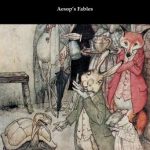I love Eric Carle’s The Very Hungry Caterpillar, so when I saw Eric Carle’s Fairy Tales and Fables, I thought I’d enjoy it too. Unfortunately, I didn’t enjoy his retellings of Aesop, Hans Christian Andersen and the Brothers Grimm.
The Very Hungry Caterpillar delights me because the colorful collage pictures follow the simple story. Each page unites in the book to be a beautiful volume of art—much like the beautiful butterfly the caterpillar is destined to become. This was one of the books I wanted most for my son when he was born, and I love to read it to him at night.
Eric Carle’s Fairy Tales and Fables is Eric Carle’s retelling of selected tales from Aesop, the Brothers Grimm, and Hans Christian Andersen. (Note: The image is the US version; I read the UK version.) His artwork is in a similar style as he’s always done—multi-layered collages. This style of art worked well for stories with animals, but the illustrations with humans were not as attractive to me. (I thought the humans in “The Wild Swans” were horribly ugly, but I suppose it’s an art preference.)
Eric Carle selected the tales based on his favorite stories as a child, but I found his selection of stories to be odd. For instance, he retold “The Seven Swabians” and after reading it I seriously thought to myself, “that was dumb.” Nothing happened in it. I suppose that’s the reason it’s not a well-known story of the Brothers Grimm. Ultimately, I disliked his re-tellings. I did not feel they were well-written. After reading a few stories aloud to my son, I skimmed the rest before deciding I was bored with this collection. I’m glad I had checked this out of the library rather than purchasing it.
My biggest annoyance was in reading “The Magic Boots,” which Eric Carle retold from a story of Hans Christian Andersen (1805-1875). Carle placed a man in a modern city. When he put on the boots, he went back to an older time; he didn’t know what was happening to him and searched for a telephone and a taxi. This may be an acceptable retelling by itself, but in a collection of fairy tales about castles, witches, and speaking animals, the presence of a taxi really threw me off. While Andersen’s original story does follow similar concepts (albeit 100 years previous), does such a setting work as a “fairy tale” besides Tom Thumb and Aesop’s fables?
What do you think? Does a modern-day world belong in a collection of fairy tales and fables such as this?





It’s too bad this one was a disappointment. I do think that fairy tales can be retold in modern settings, and some authors do it really well. But it’s something that can very easily go wrong too, and it sounds like that was the case with this book.
@Nymeth:
I think Eric Carle’s retelling might have been acceptable by itself–but it just didn’t work in this collection.